The Paramount VistaVision Process | Read more at in70mm.com The 70mm Newsletter |
| Prepared by: PARAMOUNT STUDIOS RESEARCH STAFF. Published in THEATRE CATALOG 1954-55 | Date: 20.05.2024 |
 ONE OF the first cameras to be adapted to the VV process. ONE OF the first cameras to be adapted to the VV process.
Although it is likely that not everyone will agree with all that is said in this piece it is important that all views be given the spotlight so that the facts and arguments for each of the various new techniques may be heard and allow the individual to make up his own mind about the merits of each. | More in 70mm reading: Perspecta Stereophonic Sound in70mm.com's page about VistaVision in70mm.com's Library Presented on the big screen in 7OMM Peripheral Vision, Scopes, Dimensions and Panoramas |
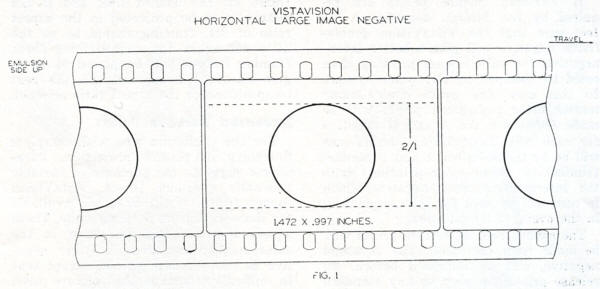 FIGURE 1 illustrates the size of the negative in the VistaVision process. If a circle were photographed it would appear as illustrated. FIGURE 1 illustrates the size of the negative in the VistaVision process. If a circle were photographed it would appear as illustrated.The most important feature of Vista-Vision is the large negative, and its optical reduction to the standard print. In VistaVision this can either be accomplished by using a special wide film negative with the subsequent photographic reduction, or the horizontal eight-sprocket hole film movement as herein explained. Tests indicate that as we increase the size of the negative, we improve picture resolution in the plane of focus and grain size reduction, but beyond a certain point we tend to lose depth of field. We believe that in our use of the VistaVision process we have selected the best ratio of negative area to positive area for motion picture making. We have established the negative width for optimum results, taking into account the image reduction factor and wide angle photography. At this width we have gained slightly in depth of field. The VistaVision system has a large gain in depth of field if the image height is maintained the same as on standard photography. The finders on the VistaVision cameras carry a hairline marking in the aspect ratio of 1.66:1. There will also be a frame line marking for the 1.33:1 aspect ratio. The cameramen are instructed to compose for a loose (meaning adequate head-room) 1.66:1 picture. A picture composed in this way will play equally well at 1.85:1; it will play very satisfactorily at 2:1, and it can be played at the old standard 1.33:1. The VistaVision cameras will be used for all future Paramount black and white pictures, as well as color pictures. It is contemplated that the same benefit will be derived on black and white that is now being gained in color photography. The production picture dailies are optically printed directly from the large color negative to the standard 35nun image size. The reduction ratio is 1.63:1. Eastman color stock is now being used for all daily prints. The editorial and studio handling of these prints is exactly the same as the previous handling of daily, except that special negative numbers are placed on both print and negative for future negative cutting. The special numbering may be eliminated when there is enough time to modify a printer so as to print-through the negative numbers. Sound Recording In our work with stereophonic sound we have found that it is overbearing and gives too much effect of movement for front seat listening, and it is of little value in the rear of theatre. Further, classical stereophonic sound tends to punctuate cuts, and detracts from the smooth flow of the pictured story. Paramount suggests Perspecta Stereophonic Sound for the very large theatres, and for use by exhibitors who feel that they should have a stereophonic or directional effect. | |
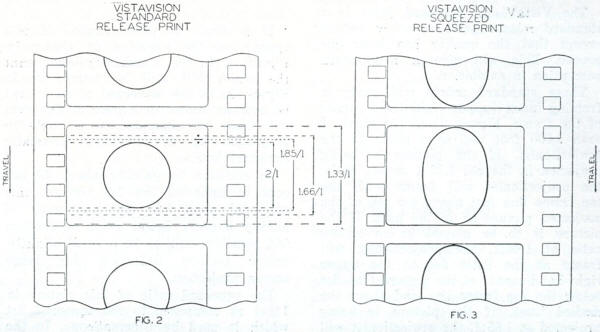 FIGURE 2 indicates standard release print and outlines the various aspect ratios that can be used. Figure 3 is an anamorphic print. FIGURE 2 indicates standard release print and outlines the various aspect ratios that can be used. Figure 3 is an anamorphic print.As indicated before, all VistaVision release prints will have standard photographic sound tracks, which will play on any existing standard optical sound heads. These same sound tracks will also carry low frequency modulation at three different frequencies which will control the volume of the center and side loud-speakers, in those theatres that are equipped with Perspecta stereophonic sound control units. These sound control units will cost about $800 plus about $500 for installation. In theatres that do not have auxiliary loudspeakers, it will, of course, be necessary to purchase extra loudspeakers and amplifiers. All houses that have been equipped for stereophonic reproduction can use directional sound by merely purchasing the integrator sound control unit. The production shooting for Vista Vision sound will be handled the same as on any monaural sound picture. At Paramount all production recording is done on 17½mm film, in the 65 pound suitcase recorders built by Paramount. All scoring will be single soundtrack magnetic with as much reverbeberant bigness as can be obtained. On future pictures, it is contemplated that all sound editing will be with striped magnetic 35mm film, and the magnetic cutting print will be used as the rerecording print. All re-recording will be to a single-sound track magnetic master which will have to be re-recorded (dubbed) with monaural monitoring. The single-track magnetic composite film will then be made stereophonic in the rerecording channel, using three horn systems and the necessary panning pots to gain any desired balance. A magnetic control track will be made during each review, and when a satisfactory review is obtained the control track will be combined with the rerecording master in the preparation of a photographic negative for release printing. With respect to the foreign handling of sound for dubbed versions, we will keep the music, sound effects, and dialogue on multi-track magnetic for shipment to the foreign studios for dubbing. The stereophonic effect for the foreign Perspecta Sound release will be effected at the time of foreign dubbing. Release Printing and Distribution All domestic, and possibly the foreign release prints, are to be made by a new imbibition dye transfer method which Technicolor has developed, and which is being introduced with the release of "White Christmas." It will also be used on all subsequent VistaVision pictures. The negative will be handled in 2,000 foot rolls corresponding to the 1,000 foot rolls of normal film. Negative cutting of Paramount VistaVision pictures will be the so-called A and B process, so that all dissolves and fades will be made from the original negative without duping. If Eastman release prints are required by the foreign department, we feel sure that the VistaVision double-frame negative will give a better inter-negative for such release printing than could be obtained by any other system. In this case fine grain double-frame master color separation prints will be made from both the A and B negative for each reel. The printing in this case will be by the so-called A and B method (similar to 16mm color printing) onto the intermediate color negative which in turn will be used for release printing in the overseas laboratories. The sound from all release prints will be made from the same type of sound negative, and as indicated before, all release prints can play on any standard optical sound head in any theatre in the world. Further, these same prints can play with stereophonic sound in theatres having a Perspecta Sound control unit. | |
 DIAGRAM demonstrates VistaVision principle of comfortable viewing. It is claimed that this process covers all three viewing areas. DIAGRAM demonstrates VistaVision principle of comfortable viewing. It is claimed that this process covers all three viewing areas.VistaVision Standard Release Prints The VistaVision standard print is a standard release print in every regard except that the quality has been improved. This will give a new depth perception in exhibition. These standard prints will carry a framing index (upper right-hand corner of the frame, Figure 2) at the start of each 2,000 foot reel as a guide to the projectionist. If the picture is being projected in the old 1.33:1 aspect ratio, the projectionist will frame with the top frame line just above the top of the projected picture as in the past. If the picture is to be played in an aspect ratio of 1.66:1, the projectionist will frame at the little dot in the upper right-hand corner of the picture (the dot below the top frame line and above the dashed line). If the picture is being projected at 1.85:1, the projectionist will frame on the dashed line, and if the picture is to be projected in the aspect ratio of 2:1, framing should be on the little dot below the dashed line. These framing indices will be placed so as to give adequate headroom and the best composition for the aspect ratio selected. Squeezed Release Prints For the exhibitors who wish complete flexibility in picture projection, Paramount suggests the purchase of variable prismatic expander lenses. VistaVision squeezed prints will be made available for those exhibitors desiring same. These squeezed prints will be made in the same manner and from the same negative as the standard prints, except that in optical reduction the picture area will be taken from the area of the negative that supplies the portion of the picture normally used in 2:1 aspect ratio projection from the standard print. If a circle is photographed it will appear on the negative as shown in Figure 1. In the standard release print the circle will still be round, as in Figure 2. In the squeezed print it will be oval as shown in Figure 3. The oval will then be expanded to a circle in projection by the variable prismatic expander lens. In addition to gaining about 40 per cent in light on the 2:1 picture, this squeezed print has the possibility of having slightly better color saturation, and possibly (still to be proved) slightly better picture definition for large screen projection. The squeezed ratio of this picture is 1½:1 as compared to the squeezed 2:1 which is used by CinemaScope. In the opinion of the writer the optics for a 1½:1 ratio will give better picture quality than a higher ratio. | |
Theatre Presentation | |
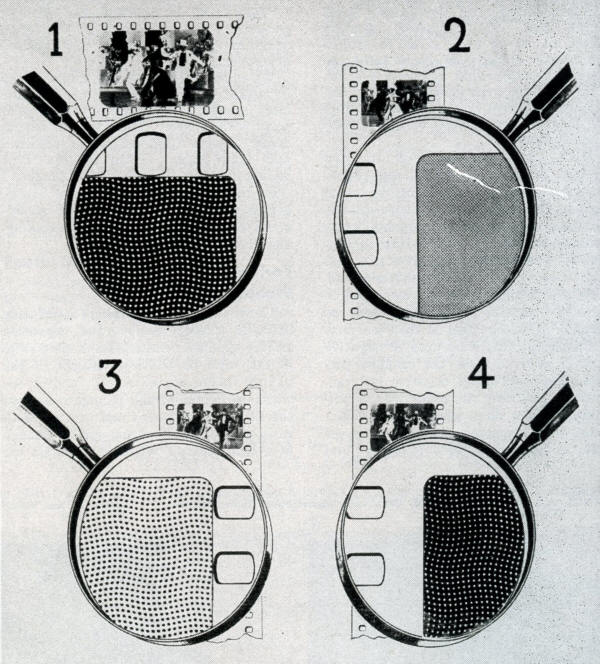 PICTURE QUALITY EXPLAINED: No. 1 shows that VistaVision negative covers two-and-a-half times the conventional size. Section under magnifying glass shows grain. No. 2 shows the VV print reduced to 35mm. size with grain reduction of 72 per cent. No. 3 shows the large grain found in a conventional negative frame. As seen in No. 4 VistaVision negatives are much sharper, thus giving a sharper picture. PICTURE QUALITY EXPLAINED: No. 1 shows that VistaVision negative covers two-and-a-half times the conventional size. Section under magnifying glass shows grain. No. 2 shows the VV print reduced to 35mm. size with grain reduction of 72 per cent. No. 3 shows the large grain found in a conventional negative frame. As seen in No. 4 VistaVision negatives are much sharper, thus giving a sharper picture.VistaVision standard prints can be projected in any theatre in the world with an improved picture quality. Further, viewing will be better than hereto-fore from the front and side seats. If the theatre is to take full advantage of the improved quality of the VistaVision print the theatre must have good projection equipment, and a large seamless screen. Motion picture studios expend hundreds of thousands of dollars in a meticulous effort to deliver the best possible technical quality, along with good entertainment. The theatres should accept their responsibility and make an equal effort in their exhibition. Screens Every theatre should install the largest feasible screen, both as to height and width. As a further recommendation in this regard, it is our belief that in the very large theatres they should install screens capable of accepting the aspect ratio of 1.85:1, unless the sight line for seats at the back of the main floor is limited by a low hanging balcony. In this case, the theatre may elect to install a screen in the ratio of 2:1. This is the only limitation that should force the theatre into an aspect ratio as high as 2:1. In theatres where the screen's width is limited to under 30 feet, and where there is adequate height, we recommend a screen aspect ratio of 1,66:1, reducing the height only when necessary for good viewing. Objective Is to Fill Screen One of the objectives of VistaVision is to fill the screen. VistaVision is a flexible system and allows adequate latitude for filling the screen. In the pre-ceding paragraphs we have named specific aspect ratios. However, the theatres should vary from these defined ratios as required to fill the screen. We realize that it is impossible to lay down fixed recommendations applicable to all theatres. We are, however, setting down some general principles and recommendations which can be used as a guide. With respect to picture size, in the past the most acceptable picture quality has been at a distance from the screen between two and five times screen width, this has been from 50 to 125 feet from the screen. On the basis of the same old picture quality, if the screen width were increased to 50 feet, the most acceptable picture quality would be between 100 and 250 feet from the screen. This reaches beyond the back wall in most theatres. If people are seated closer, they see film grain and the picture is fuzzy and tiring to the eyes. This applies to both straight and anamorphic projection of all previous pictures. VistaVision pictures, starting with White Christmas, can be viewed with ease and comfort from one-half to eight times screen width. With Vista-Vision on a screen 50 feet wide, the seating will be acceptable down to 25 feet from the screen and will be very satisfactory at 38 feet from the screen. This is the answer to front seating. Side seating is also improved by the better definition and relative freedom from film grain which is accomplished by the VistaVision process. There is also another "rule of thumb" method for determining best screen width—namely, "the best screen width should not be more than one-third the distance from the screen to the center of seating, and the screen width should not be less than one-sixth the distance from the screen to the back of the auditorium. The center of seating in most balcony theatres is about three-fourths the distance from the screen to the back row of seats." With the Paramount process this rule can be changed to "the screen width can be increased to one-half the distance from the screen to the center of seating." As an example, if a theatre is 100 feet deep, the best viewing will be on a screen 38 feet wide. The previous width for the old pictures would be 25 feet. As another example, if a screen 50 feet wide is installed in a theatre 100 feet deep, the screen will be too wide and viewing will be uncomfortable unless seats are moved back to at least 25 feet and preferably 38 feet from the screen. With respect to screen height, Paramount has made a series of tests which indicate that the same scene always looks better and the actors can always be brought closer to the audience, as the height of the screen is increased with respect to width up to the ratio of 1.85:1 for large screens and 1.66:1 for smaller screens. This is in keeping with the recommendation made earlier in this writing. Screen height, the same as screen width, is usually limited by the proscenium. However, screen height may also be limited in balcony houses by the maximum height that can be seen from the back row of the main floor where the sight line is eclipsed by the over-hang of the balcony. | |
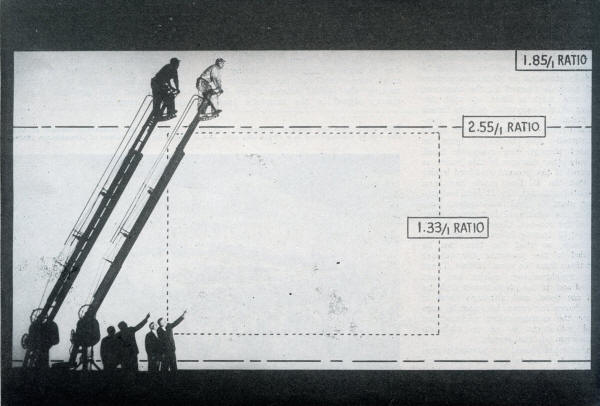 DOTTED line shows comparison of VistaVision aspect ratio with old standard. Broken line is a comparison with the CinemaScope 2.55:1 ratio. DOTTED line shows comparison of VistaVision aspect ratio with old standard. Broken line is a comparison with the CinemaScope 2.55:1 ratio.We recommend curving metallic screens with a radius equal to the projection throw or in long narrow houses this radius may be increased to one and one-fourth or one and one-half times projection throw. We also recommend tilting the screen back slightly at the top in theatres that have very high projection angles. The angle of tilt should not be over one-third the projection angle, and the writer is opposed to tilting the screen over five degrees. | |
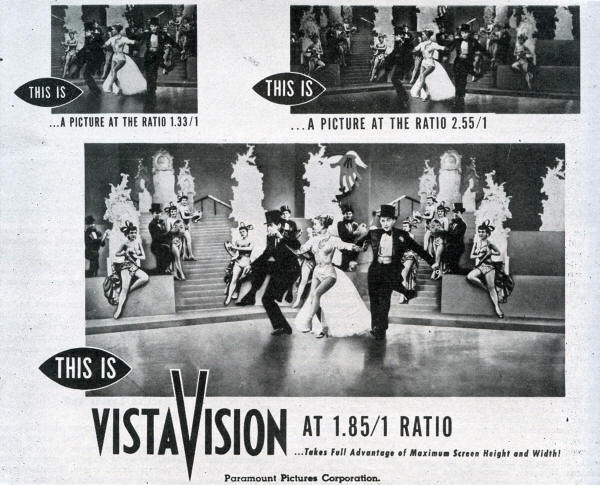 EXAMPLES of the different aspect ratios are illustrated here. Compare the old 1.33 to 1 ratio (top, left) with VistaVision aspect ratio. Then compare the 2.55 to 1 ratio aspect ratio (top, right). It is up to the individual to decide if the VistaVision ratio of 1.85 to 1 gives the clearest picture. EXAMPLES of the different aspect ratios are illustrated here. Compare the old 1.33 to 1 ratio (top, left) with VistaVision aspect ratio. Then compare the 2.55 to 1 ratio aspect ratio (top, right). It is up to the individual to decide if the VistaVision ratio of 1.85 to 1 gives the clearest picture.Variable Prismatic Expander Lenses There is a great deal of confusion between aspect ratios and squeezed and/or expansion ratios. The aspect ratio is the ratio of width to height of the picture image on the screen, and/or the width to height of the picture image on the film. The squeezed and/or expansion ratio is the result of an optical change in a lens system. When the images are squeezed they are made to appear thin and tall. When these thin and tall images are expanded in projection; they appear normal on the screen. In the CinemaScope system the camera lens picks up a scene that is 2.66 times as wide as it is high. This scene is squeezed horizontally in the squeeze ratio of 2:1, which gives a negative image in the aspect ratio of 1,33:1. A print made from this negative is still squeezed. In CinemaScope projection, the image passes through an anamorphic expander lens which expands the image in the ratio of 2:1. This would normally give a screen aspect of 2.66:1. In the Cinema-Scope process the sides of the picture are cropped down to make room for the magnetic stereophonic sound tracks, so that the final aspect ratio of the picture when projected is in the ratio of 2.55:1. In the VistaVision process, standard camera lenses are used in photography and a standard large negative image is obtained. When desired, squeezed prints are made during the process of optical printing, but in the case of VistaVision the squeeze ratio is 1½:1. When these prints are projected, they must be projected through an expander lens working in the ratio of 1½:1, which gives a screen image in a 2:1 aspect ratio. At the present time there are three types of anamorphic lenses being manufactured. They are the cylindrical lens type, such as used by CinemaScope; the reflector lens type; and the prismatic type. Of these three types of lenses, the prismatic type is the only one that can be made variable. The variable prismatic expander lens, has the capability of projecting in any ratio of squeeze, from a ratio of 1:1 to 3:1. In the 1:1 position these lenses will project standard prints either of the old standard type or the VistaVision standard type. Thus, the variable prismatic expander lens provides complete flexibility in the projection booth for the exhibition of any print. | |
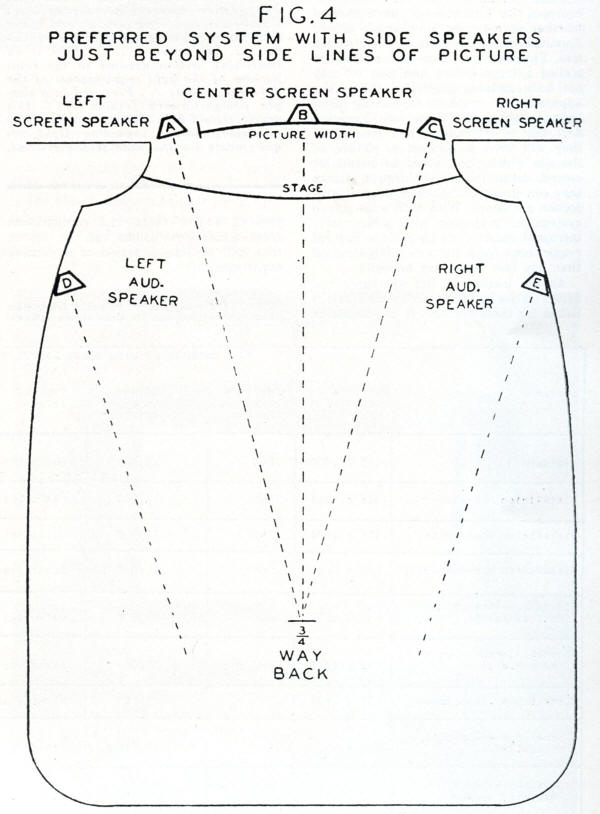 The Paramount recommended system for directional sound is at. The Paramount recommended system for directional sound is at.Theatre Sound As stated before, all VistaVision release prints, both standard and squeezed, will have a single photographic sound track located in the standard position, so that they will reproduce on any standard optical sound head in any projector throughout the world. The sound track will also carry low frequency modulated control signals which will control the direction of sound reproduction in theatres that are equipped for directional or stereophonic sound. Perspecta Sound will expand music to multiple loudspeakers and control the direction of the sound source when, and as it is required for dramatic effective-ness. Paramount suggests this type of sound for those exhibitors who desire multi-horn reproduction, and who wish to fill the theatre with sound. The decision as to its use rests with the exhibitor. For VistaVision stereophonic sound it is only necessary to have three loud-speakers, as shown by A, B and C, in Figure 4. In very wide theatres and very large theatres, the addition of auditor um speakers at D and E may improve the sound effectiveness. These auditorium loudspeakers, if used, should be located well to the front of the auditorium. Loudspeaker D should be connected to the same electrical circuit as loudspeaker A, but operated at a lower level, and loudspeaker E should be connected to the same electrical circuit as loudspeaker C, and also operated at a lower level. The control units for Perspecta Sound will be available from Westrex, Fairchild, Altec-Lansing, and other manufacturers. The theatre service companies will have complete instructions, in regard to their installation and operation. Paramount will have no magnetic sound release. It is our opinion that this move will give greater simplicity and flexibility at a lower cost: The sound control units will have an automatic return to monaural sound in case of trouble. Booth Operation Booth operation is simplified to the bare essentials in all theatres that use the VistaVision standard prints and monaural sound. VistaVision also offers the simplest and most flexible system for those theatres that wish to play squeezed prints through variable prismatic expander lenses. VistaVision, with its directional sound, simplifies operation in theatres equipped with multi-speaker reproduction. Drive-In Presentation Drive-ins can use the VistaVision standard release prints and project them in the same manner as any standard release print. The improved quality of the VistaVision print should be very apparent in the outdoor theatres. It seems to the writer that drive-ins can best be served by using a screen in the ratio of 2:1, and using the squeezed prints along with variable prismatic ex-pander lenses, working at the expansion ratio of 1½:1, as established for the VistaVision prints. As stated previously, standard sound is available on all VistaVision release prints so that no change will be required in handling VistaVision sound for drive-ins. | |
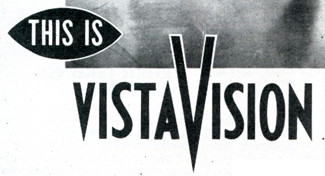 • Go to The Paramount VistaVision Process | |
| Go: back - top - back issues - news index Updated 20-05-24 |
